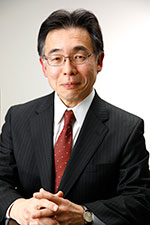Message from the Dean (From April 2017 To March 2019)
Diverse but United: Intellectual Life on the Komaba Campus
Atsushi Ishida
The Dean of the College of Arts and Sciences
The Dean of the Graduate School of Arts and Sciences
 In a bird's-eye view, today's Komaba Campus of the University of Tokyo remains, to our great relief, green and peaceful. An even wider view would let you realize that it is adjacent to the Komaba-no Park and the Komaba Park, in the latter of which you find the landmark Western-style mansion of the Maeda family as well as the Museum of Modern Japanese Literature. The Clock Tower (Building No. 1), the Lecture Hall (Classroom No. 900), and the Museum of Art and Science, located at the center of the campus, were built in the 1930s, reminiscent of the time when Dai-ichi Koto Gakko (the First High School) was relocated from Hongo to Komaba.
In a bird's-eye view, today's Komaba Campus of the University of Tokyo remains, to our great relief, green and peaceful. An even wider view would let you realize that it is adjacent to the Komaba-no Park and the Komaba Park, in the latter of which you find the landmark Western-style mansion of the Maeda family as well as the Museum of Modern Japanese Literature. The Clock Tower (Building No. 1), the Lecture Hall (Classroom No. 900), and the Museum of Art and Science, located at the center of the campus, were built in the 1930s, reminiscent of the time when Dai-ichi Koto Gakko (the First High School) was relocated from Hongo to Komaba.
As of 2017, Komaba is the home of a total of approximately 9,000 people. Freshmen and sophomores in the College in six streams (three streams in humanities and social sciences and three streams in natural sciences) form a substantial part of this community (they add up to about 6,600). In addition, juniors and seniors in the College (about 400) and graduate students and research students in the Graduate School of Arts and Sciences and the Graduate School of Mathematical Sciences (about 1,700) are also parts of the core of this community. Furthermore, around 400 full-time academic staff members (professors, associate professors, lecturers, and assistant professors) teach classes both in the College and the Graduate School of Arts and Sciences. Finally, around 100 hard-working administrative staff members form the backbone of all the activities on this campus. This variety of people share an eventful year on the campus, including the happy orientation week for newly enrolled students under blossoming cherry trees in April, the lively school festival in the scenic fall foliage (Komaba Festival), the tensely quiet entrance examinations in January and February, and the commencement ceremony filled with a true sense of achievement in March.
The diverse membership of the Komaba community is not just a product of our size. Our diversity derives from the foundational vision of college education at the University of Tokyo.
Based on our understanding that the limited knowledge and consequently biased preferences of newly enrolled students at the time of admission would not let them make prudent choices of their majors, the University of Tokyo has them decide their field of specialization not in the early but in the late phase of their college education ("late specialization") after the experience of their first three semesters in college has broadened their range of knowledge and has nurtured sound judgement. This is why a wide range of courses, from foreign languages and humanities to social and natural sciences, are offered to our college students in both the humanities and social sciences streams and the natural sciences streams. The foundational courses for freshmen and sophomores are the responsibility of 27 academic departments (bukai).
The history of research and education in universities has witnessed not only a steady expansion of human intellectual horizons but also an endless specialization in increasingly narrowly demarcated academic disciplines. This latter process of specialization has not gone on without generating the opposite process: integrating distinct disciplines to reach a synthetic understanding of the multifaceted reality of today's world. If you try to tackle one of the many complex problems confronting human society without an integrated understanding of related issues, your solution might just cause bigger problems. As shown, for example, by the many problems involving sustainability, from energy supply to social security for an aging population, fixes for today's problems are meaningless if they impose a burden on future generations.
The academic staff on the Komaba campus, as stated above, are responsible for a wide range of foundational courses for freshmen and sophomores of the College. This is the reason why the same academic staff are perfectly equipped also to offer a set of degree programs (B.A., M.A., and Ph.D. programs) over a broad spectrum of academic disciplines. These programs are all known for their interdisciplinary nature. The key words for the intellectual activities on this campus are therefore adjectives such as "integrated" and "interdisciplinary."
The intellectual life on the Komaba campus is, thus, diverse but united. This is the source of our vitality, which I believe will keep Komaba always promising.
PEAK & GPEAK Welcome Ceremony/September 21, 2018
PEAK & GPEAK Welcome Ceremony/September 22, 2017
